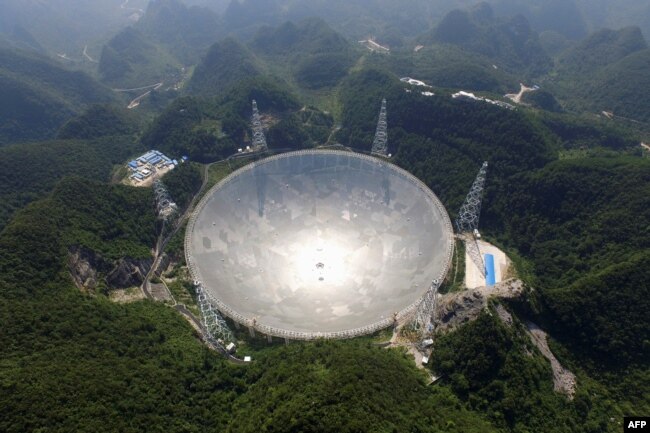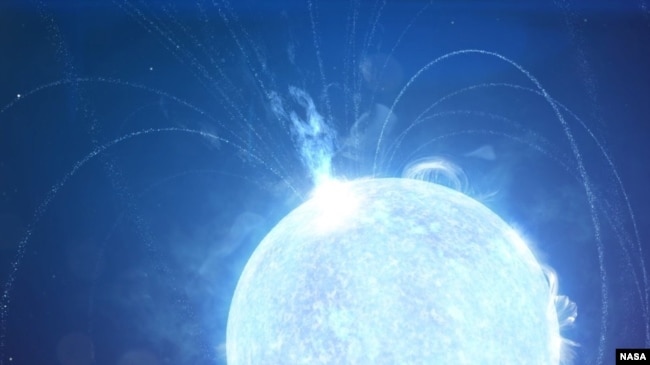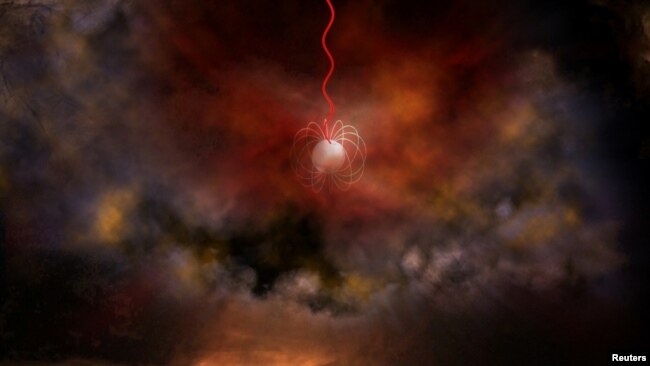科学者が求める 高速電波バーストの”黄金の測定法” !!
FRBsの原因は? その意味することは?
宇宙の謎を解く鍵!!
VOAで英語を学び、語彙を増やしましょう!!
宇宙で発生した高速電波バーストの原因を探る(和訳)
Scientists Consider Cause of Fast Radio Bursts in Space
June 20,2022
2007年、ウェストバージニア大学の科学者たちは、宇宙からの異常な強い電波のバーストを初めて確認しました。それ以来、この高速電波バースト、FRBs 、は天文学者にとって謎のままでした。
FRBsは電波のパルスであり、我々の銀河系や他の銀河系からやってくるということだけ分かっていました。
しかし最近、研究者たちは2019年にFASTと呼ばれる世界最大の単皿電波望遠鏡で初めて発見されたFRBを特定しました。場所は中国の貴州省です。このFRBは、アメリカのニューメキシコ州にあるVLA望遠鏡を使ってさらに研究され、地球から30億光年近く離れた非常に小さな銀河の中にあることがわかりました。1光年とは、光が1年で進む距離のことです。
科学者たちは、極端な天体がこの高速電波バーストを放出しているのではないかと考えています。その天体には、中性子星のような珍しい種類の星が含まれている可能性があります。中性子星は、超新星爆発を起こした一生の終わりにある大きな星の中心部です。また、マグネターと呼ばれる、非常に強い磁場を持つ中性子星も考えられます。また、ブラックホールが近くの星を食べると、FRBが発生する可能性があります。
ケイシー・ロウ氏はカリフォルニア工科大学の天文学者です。ネイチャー誌に掲載された2019年のFRBに関する最近の研究の共同執筆者です。彼によると、FRBはわずか1ミリ秒の間にオンとオフを繰り返す、電波エネルギーの素早い閃光だと言います。宇宙全体で観測することができます。FRBを繰り返す嵐を起こす天体もあれば、一度だけバーストする天体もあります。
Nature
2019年FRBは繰り返します。バーストとバーストの間に弱い電波が続くので、常に”オン”になっているように見えます。知られているFRBsのほとんど、500個近くは、繰り返しません。
天文学者は、Natureの研究で説明されたFRBは、その生命の始まりに過ぎないと考えています。中性子星を作った超新星爆発からの厚い物質にまだ囲まれています。科学者たちは、繰り返されるバーストは、より若いFRBsから来るのではないかと考えています。
ディ・リ 氏は、北京にある中国科学院のFAST望遠鏡のチーフサイエンティストで、Nature誌の共同執筆者です。彼は、「我々は未だに高速電波バーストを宇宙の謎と呼んでおり、それはその通りです。」と言っています。
FRBsはまだ完全に解明されていませんが、この新しく繰り返しているFRBは、科学者が電波バーストの原因を発見するのに役立つかもしれません。数年前、科学者たちはガンマ線バーストと同様の謎に直面しました。現在では、これらの現象は非常に大きな星の死、または中性子星やマグネターが結合してブラックホールを形成することによって起こると考えられています。
しかし、FRBsについては、まだまだ解明すべきことがたくさんあります。
「私たちは、この現象について発生源の場所、発生頻度など、もっともっと多くのことを分かっています。…しかし、その原因について決定的な答えを与えてくれる黄金の測定法を、私たちはまだ追い求めているのです。」とロウ氏は話しています。
Scientists Consider Cause of Fast Radio Bursts in Space
In 2007, scientists at West Virginia University first identified an unusual intense burst of radio waves from space. Since then, these fast radio bursts, or FRBs, have been a mystery to astronomers.
They only knew that FRBs are pulses of radio waves and that FRBs come from places within our galaxy, the Milky Way, and other galaxies.
Recently though, researchers identified an FRB that was first found in 2019 with the world’s largest single-dish radio telescope, called FAST. It is in the Guizhou Province in China. The FRB was studied more using the VLA telescope in the state of New Mexico in the U.S. The FRB is in a very small galaxy, which is almost 3 billion light-years from Earth. A light year is the distance light travels in one year.
Scientists believe that extreme objects may release these fast radio bursts. These objects could include unusual kinds of stars such as a neutron star. A neutron star is the center of a large star at the end of its life cycle that explodes as a supernova. Another is a magnetar, which is a neutron star with a very strong magnetic field. And another possible cause of an FRB is a black hole eating a nearby star.
Casey Law is an astronomer at the California Institute of Technology. He was co-writer of a recent study of the 2019 FRB that was published in Nature. He said FRBs are quick flashes of radio energy that turn on and off for only a millisecond. They can be observed across the universe. Some objects produce a storm of repeated FRBs, and some only burst once.
The 2019 FRB repeats. Weaker radio signals continue between the bursts, so it appears to be always “on.” Most known FRBs, nearly 500 of them, do not repeat.
Astronomers think that the FRB described in the Nature study is only in the beginning of its life. It is still surrounded by thick material from the supernova explosion that created a neutron star. The scientists suspect that the repeating bursts come from younger FRBs.
Di Li is the chief FAST telescope scientist and with the Chinese Academy of Sciences in Beijing. He co-wrote the Nature study. He said, “We still call fast radio bursts a cosmic mystery and rightfully so.”
Although FRBs are still not completely understood, the new repeating FRB may help scientist discover the cause of radio bursts. Years ago, scientists faced a similar mystery with gamma-ray bursts. These events are now believed to result from the death of very large stars, or from neutron stars or magnetars joining to form a black hole.
But researchers have a lot more to learn about FRBs.
"We know more and more about the phenomenon, where the sources live, how often they burst…However, we are still chasing for that golden measurement that will give us a definitive answer to what causes them,” Law said.
Words in This Story
astronomer –n. a scientist who studies stars, planets and objects in outer space
pulse – n. a short increase in an amount of electricity, light or sound
light year – n. the distance light travels in a year, about 9.5 trillion kilometers
supernova – n. a star that has exploded, strongly increasing its brightness for a period of time
black hole – n. a very dense area in space where the gravitational pull is so powerful that nothing, not even light, can escape
cosmic – adj. of or relating to the universe or outer space
phenomenon – n. an event or interesting happening that can be observed and studied and that is not easy to explain or understand
definitive – adj. clear, sure and not likely to change


